
Canidae is a biological family of dog-like carnivorans, colloquially referred to as dogs, and constitutes a clade. A member of this family is also called a canid. There are three subfamilies found within the canid family, which are the extinct Borophaginae and Hesperocyoninae, and the extant Caninae. The Caninae are known as canines, and include domestic dogs, wolves, foxes, coyotes and other extant and extinct species.

Borophagus is an extinct genus of the subfamily Borophaginae, a group of canids endemic to North America from the Middle Miocene epoch through the Late Pliocene epoch 12—2 Mya.

Aelurodon is an extinct canine genus of the subfamily Borophaginae which lived from the Barstovian land mammal age of the middle Miocene to the late Miocene epoch. Aelurodon existed for approximately 10.7 million years.
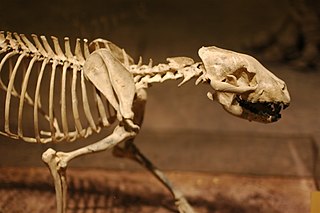
The extinct Borophaginae form one of three subfamilies found within the canid family. The other two canid subfamilies are the extinct Hesperocyoninae and extant Caninae. Borophaginae, called "bone-crushing dogs", were endemic to North America during the Oligocene to Pliocene and lived roughly 36—2.5 million years ago, existing for about 33.5 million years.

Hesperocyon is an extinct genus of canids that was endemic to North America, ranging from southern Canada to Colorado. It appeared during the Uintan age–Bridgerian age (NALMA) of the Mid-Eocene 42.5 mya—31.0 Ma. (AEO). Hesperocyon existed for approximately 11.5 million years.

The Caninae, known as canines, are one of three subfamilies found within the canid family. The other two canid subfamilies are the extinct Borophaginae and Hesperocyoninae. The Caninae includes all living canids and their most recent fossil relatives. Their fossils were first found in North America and dated to the Oligocene era, then spreading to Asia at the end of the Miocene era, some 7 million to 8 million years ago.
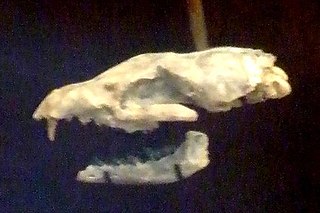
Archaeocyon is an extinct genus of the Borophaginae subfamily of canids native to North America. It lived during the Oligocene epoch 32-24 Ma., existing for approximately 8 million years. Species of Archaeocyon are among the earliest known borophagines, although a species of Otarocyon has a slightly earlier first appearance. Fossils have been found across the northern Great Plains and along the west coast of North America.

Cynarctus is an extinct genus of the Borophaginae subfamily of canids native to North America. The genus was first founded by W. D. Matthew in 1901, based from a pair of lower jaws, Cynarctus saxitilis, found in the Pawnee Creek Beds of Colorado. It lived during the Middle to Late Miocene 16.0—10.3 mya, existing for approximately 5.7 million years. Fossils have been uncovered in Colorado, California, Maryland, western Nebraska, and Texas. It was likely an omnivore, and lacked the bone-cracking adaptations found in some later borophagines. Newer findings have proved the genus to be described as a large dog-like raccoon, a result from combining characteristics from Canidae with Procyonidae.
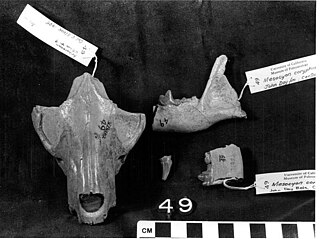
Mesocyon is an extinct genus of the Hesperocyoninae subfamily of early canids native to North America. It lived from the Oligocene to Early Miocene, 30.3—20.3 Ma, existing for approximately 10 million years. Fossils are known from Oregon, southern California and the northern Great Plains. It was roughly coyote-sized, and the first known canid to have a primarily meat-based diet.

Enhydrocyon is an extinct genus of bone crushing canid which inhabited North America during the Oligocene and Early Miocene, 30.8—20.4 Ma, existing for approximately 11 million years.
Prohesperocyon is an extinct genus of the first canid endemic to North America appearing during the Late Eocene around 36.6 mya (AEO).

Sunkahetanka is an extinct monospecific genus of the Hesperocyoninae subfamily of early canids native to North America. It lived during the Oligocene, 30.8—26.3 Ma, existing for approximately 5 million years. In form, it was intermediate between the small Cynodesmus and the later Enhydrocyon, the first hypercarnivorous, "bone-cracking", canid.
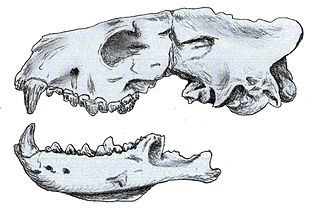
Philotrox is an extinct monospecific genus of the Hesperocyoninae subfamily of early canids native to North America. It lived during the Oligocene, 30.8—26.3 Ma, existing for approximately 5 million years. In form, it was intermediate between the small Cynodesmus and the later Enhydrocyon, the first hypercarnivorous, "bone-cracking", canid.
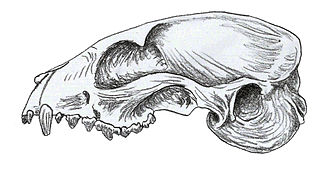
Otarocyon is an extinct genus of the Borophaginae subfamily of canids native to North America. It lived during the Oligocene epoch, about 33.3—20.6 Ma. Fossils have been found only in Montana, Wyoming, and South Dakota.
Euoplocyon is an extinct genus of the Borophaginae subfamily of canids native to North America. It lived during the Early to Middle Miocene, 20.6—13.6 Mya, existing for about 7 million years. A member of the Borophagini tribe, it was an intermediate-sized canid, with specialisations towards a heavily meat-based diet.

Paratomarctus is an extinct monospecific genus of the Borophaginae subfamily of canids native to North America. It lived from the Middle to Late Miocene, 16.3—5.3 mya, existing for approximately 11 million years. It was about the size of a coyote, and was probably a generalised predator, without the specialised adaptations of most later borophagines.
Microtomarctus is an extinct monospecific genus of the Borophaginae subfamily of canids native to North America. It lived during the Early to Middle Miocene, and existed for approximately 7 million years. Fossil specimens have been found in Nebraska, coastal southeast Texas, California, New Mexico, Nevada and Colorado. It was an intermediate-size canid, and more predaceous than earlier borophagines.
Cynarctina is an extinct clade of the Borophaginae subfamily of canids native to North America. They lived from the Early to Middle Miocene 16.0—10.3 Ma, existing for approximately 5.7 million years. Cynarctines had rounded cusps on the molar teeth, similar to those seen in living bears, suggesting that they were likely omnivores.
Borophagina is a subtribe of the Borophaginae, a group of extinct canids. They inhabited much of North America from the Early Miocene to the Zanclean stage of the Pliocene, 20.6—3.6 Mya, and existed for approximately 17 million years.

Tephrocyon is an extinct genus of the Borophaginae subfamily of canids native to North America. They lived during the Barstovian stage of the Middle Miocene 16.3—13.6 million years ago, existing for roughly 2.7 million years. It is a rarely found genus, with fossil deposits only occurring in western Nebraska, Wyoming, eastern Oregon, New Mexico, and north Florida. It was an intermediate-sized canid, and more predatory than earlier borophagines.

















